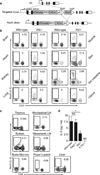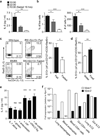Type 2 innate lymphoid cells control eosinophil homeostasis
- PMID: 24037376
- PMCID: PMC3795960
- DOI: 10.1038/nature12526
Type 2 innate lymphoid cells control eosinophil homeostasis
Abstract
Eosinophils are specialized myeloid cells associated with allergy and helminth infections. Blood eosinophils demonstrate circadian cycling, as described over 80 years ago, and are abundant in the healthy gastrointestinal tract. Although a cytokine, interleukin (IL)-5, and chemokines such as eotaxins mediate eosinophil development and survival, and tissue recruitment, respectively, the processes underlying the basal regulation of these signals remain unknown. Here we show that serum IL-5 levels are maintained by long-lived type 2 innate lymphoid cells (ILC2) resident in peripheral tissues. ILC2 cells secrete IL-5 constitutively and are induced to co-express IL-13 during type 2 inflammation, resulting in localized eotaxin production and eosinophil accumulation. In the small intestine where eosinophils and eotaxin are constitutive, ILC2 cells co-express IL-5 and IL-13; this co-expression is enhanced after caloric intake. The circadian synchronizer vasoactive intestinal peptide also stimulates ILC2 cells through the VPAC2 receptor to release IL-5, linking eosinophil levels with metabolic cycling. Tissue ILC2 cells regulate basal eosinophilopoiesis and tissue eosinophil accumulation through constitutive and stimulated cytokine expression, and this dissociated regulation can be tuned by nutrient intake and central circadian rhythms.
Figures




Comment in
-
Keeping eosinophils on time--ILC2 it!Nat Rev Immunol. 2013 Nov;13(11):774-5. doi: 10.1038/nri3549. Epub 2013 Oct 7. Nat Rev Immunol. 2013. PMID: 24096334 No abstract available.
References
-
- Rothenberg ME, Hogan SP. The Eosinophil. Annual Review of Immunology. 2006;24:147–174. - PubMed
-
- Takatsu K, Nakajima H. IL-5 and eosinophilia. Curr Opin Immunol. 2008;20:288–294. - PubMed
-
- Pope S, et al. IL-13 induces eosinophil recruitment into the lung by an IL-5 and eotaxin-dependent mechanism. J Allergy Clin Immunol. 2001;108:594–601. - PubMed
-
- Kopf M, et al. IL-5-deficient mice have a developmental defect in CD5+ B-1 cells and lack eosinophilia but have normal antibody and cytotoxic T cell responses. Immunity. 1996;4:15–24. - PubMed
Publication types
MeSH terms
Substances
Grants and funding
- P01 AI078869/AI/NIAID NIH HHS/United States
- P01 HL024136/HL/NHLBI NIH HHS/United States
- P30 DK063720/DK/NIDDK NIH HHS/United States
- T32 AI007334/AI/NIAID NIH HHS/United States
- T32 GM007618/GM/NIGMS NIH HHS/United States
- P01 HL107202/HL/NHLBI NIH HHS/United States
- DP1 AR064158/AR/NIAMS NIH HHS/United States
- R01 AI026918/AI/NIAID NIH HHS/United States
- DK063720/DK/NIDDK NIH HHS/United States
- U19 AI077439/AI/NIAID NIH HHS/United States
- T32 AI007641/AI/NIAID NIH HHS/United States
- T32 HD044331/HD/NICHD NIH HHS/United States
- R37 AI026918/AI/NIAID NIH HHS/United States
- R01 AI030663/AI/NIAID NIH HHS/United States
- AI026918/AI/NIAID NIH HHS/United States
- AI007334/AI/NIAID NIH HHS/United States
- HHMI/Howard Hughes Medical Institute/United States
- AI030663/AI/NIAID NIH HHS/United States
- AI007641/AI/NIAID NIH HHS/United States
- AI078869/AI/NIAID NIH HHS/United States
- HL107202/HL/NHLBI NIH HHS/United States
LinkOut - more resources
Full Text Sources
Other Literature Sources
Molecular Biology Databases
Research Materials

